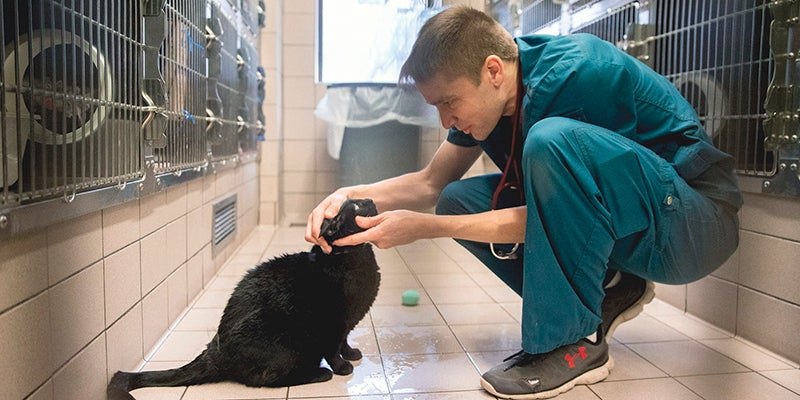Minnesota vet clinics are struggling to keep up
Published 5:44 pm Tuesday, October 5, 2021

- On a daily basis at the University of Minnesota’s Lewis Small Animal Hospital, there’s a near-constant flow of pets coming in — cats meowing from their carriers, dogs walking in with their ears drooping and tails low. Evan Frost/MPR News 2020
|
Getting your Trinity Audio player ready...
|
By Peter Cox
On a daily basis at the University of Minnesota’s Lewis Small Animal Hospital, there’s a near-constant flow of pets coming in — cats meowing from their carriers, dogs walking in with their ears drooping and tails low.
It’s become so busy that every once in a while, they just have to close their doors because they have no more room.
“We have never closed our ER prior to the pandemic,” said Mike Henson, the interim director of the pet hospital at the university’s Veterinary Medical Center. “And now it’s paused a few hours every day where we can’t admit new patients. That’s only since the pandemic. Again, we never would have considered [temporary closures] two years ago.”
Henson said that across the state, animal ERs are consistently booked up. In many cases, clients experience long waits or they’re referred to other emergency vets. The problem has become so widespread that staff at vet clinics and hospitals routinely reach out to facilities in other regions to see whether they can take on more clients.
Veterinarians, under constant stress and with smaller staffs, sometimes have to turn people and their animals away.
“They want to be able to care for every patient that would come through their doors and we can’t do that right now,” said Henson. “There’s just not enough room. And there’s not enough people to be able to do it.”
One of the biggest issues is a lack of veterinary technicians. Graham Brayshaw, the director of animal services at the Animal Humane Society, said there are fewer places for technicians to train.
“Minnesota School of Business, Argosy, Globe University — they produced most of our local vet techs,” he said.
All those schools closed in the last five years after not meeting federal standards. Those closures leave the state with just a handful of programs.
In addition to fewer techs entering the job market, Brayshaw said there is a lot more stress and strain on those workers already in the field. And it’s a career that tops out around $45,000 or $50,000 a year with a lot of student debt.
“It’s all pressures that were coming and they were just brought to the forefront a lot faster with the pandemic,” he said.
Similarly, veterinarians are feeling the squeeze. Many decided to retire during the pandemic, and there are a limited number of incoming class slots for new veterinarians.
At the same time, demand for vets has risen because many people got a new pet during the pandemic.
Jodi Harrod, the hospital administrator at South Metro Animal Emergency Care in Apple Valley, said people also noticed more issues with their pets during the pandemic.
“So pets are very different when their owners are home,” she said. “Now you’re home with them all day. Well, he’s doing what he typically does, he’s sleeping.”
There’s also a backlog of wellness checkups and other routine visits that were delayed by the pandemic.
All of that has combined for longer waits at pet hospitals and longer waits to be seen for regular checkups. For pet owners, the experience has been frustrating and has sometimes led to confrontations with employees, which has been tough on veterinary staff.
“These guys put their heart and soul into this,” Harrod said. “And when you get yelled at on a daily basis by people who are frustrated and you know, and I, we, can’t blame the clients. They’ve got a pet that they think is really sick.”
The Minnesota Veterinary Medical Association is working to address some of these issues. Connie Sillerud, the president of the association and owner of Companion Animal Eye Center in Golden Valley, said the MVMA is pushing legislation that would allow vet techs to take on more responsibility.
“Make the profession more attractive to prospective veterinary technicians. And to get them better working conditions, better pay, better benefits,” she said.
Sillerud also encourages people to make sure when they get a new pet that the pet has already been examined by a veterinarian. She also said if you make an appointment with a veterinarian, keep it. And Sillerud said people should be sure it’s an emergency before taking a pet to the ER.
“We’re trying to also point out to pet owners that our profession is overstretched,” she said. “Whether you’re being seen as an emergency visit or a regular visit, be kind and be patient.”




